Abstract
OBJECTIVE: To test the hypothesis that nitric oxide is a modulator of ileal water and ion transport. SUMMARY BACKGROUND DATA: Nitric oxide is produced in the vascular endothelium and enteric neural plexuses of the intestine and is involved in gastrointestinal motility and smooth muscle contractility. Little is known about the role of nitric oxide in intestinal epithelial transport. METHODS: Ten-centimeter rabbit ileal segments (n = 50) were vascularly perfused with an electrolyte solution containing red cells. The lumen was perfused with a solution containing 14C-PEG. Net fluxes of water and ions were calculated during three 20-minute periods: basal, drug infusion, and recovery. Perfusion pressure was recorded to document changes in vascular resistance. Agents infused included the nitric oxide synthase substrate L-arginine, the nitric oxide source sodium nitroprusside, the substrate control D-arginine, and the nitric oxide synthase inhibitor NG-nitro-L-arginine methyl ester. RESULTS: L-arginine and sodium nitroprusside caused absorption of water and ions. NG-nitro-L-arginine methyl ester caused secretion of water and ions, which was prevented by synchronous infusion of L-arginine. Infusion of D-arginine had no effect. Both L-arginine and sodium nitroprusside caused mild vasodilation. CONCLUSIONS: Inhibition of endogenous nitric oxide synthesis by NG-nitro-L-arginine methyl ester causes secretion of water and ions. This secretion is reversed by administration of the nitric oxide synthase substrate L-arginine. These findings are consistent with the hypothesis that endogenous nitric oxide has a proabsorptive influence over the ileum in the basal state.
Full text
PDF
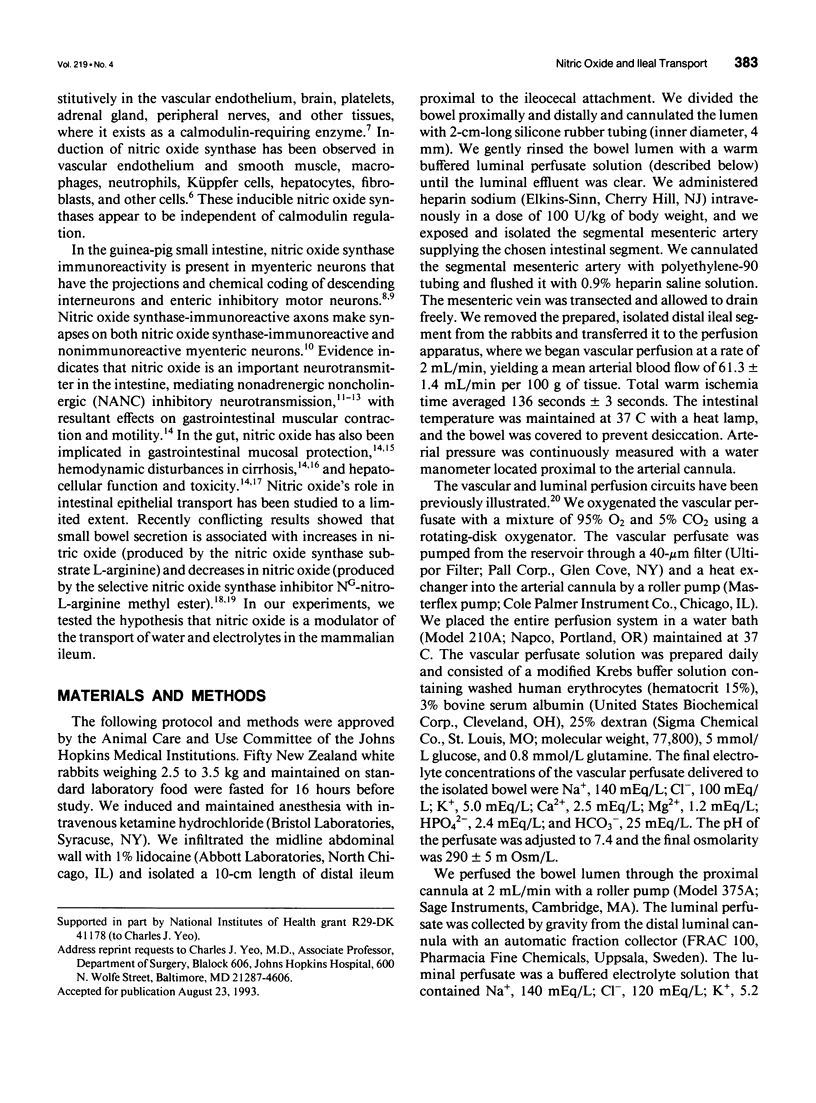
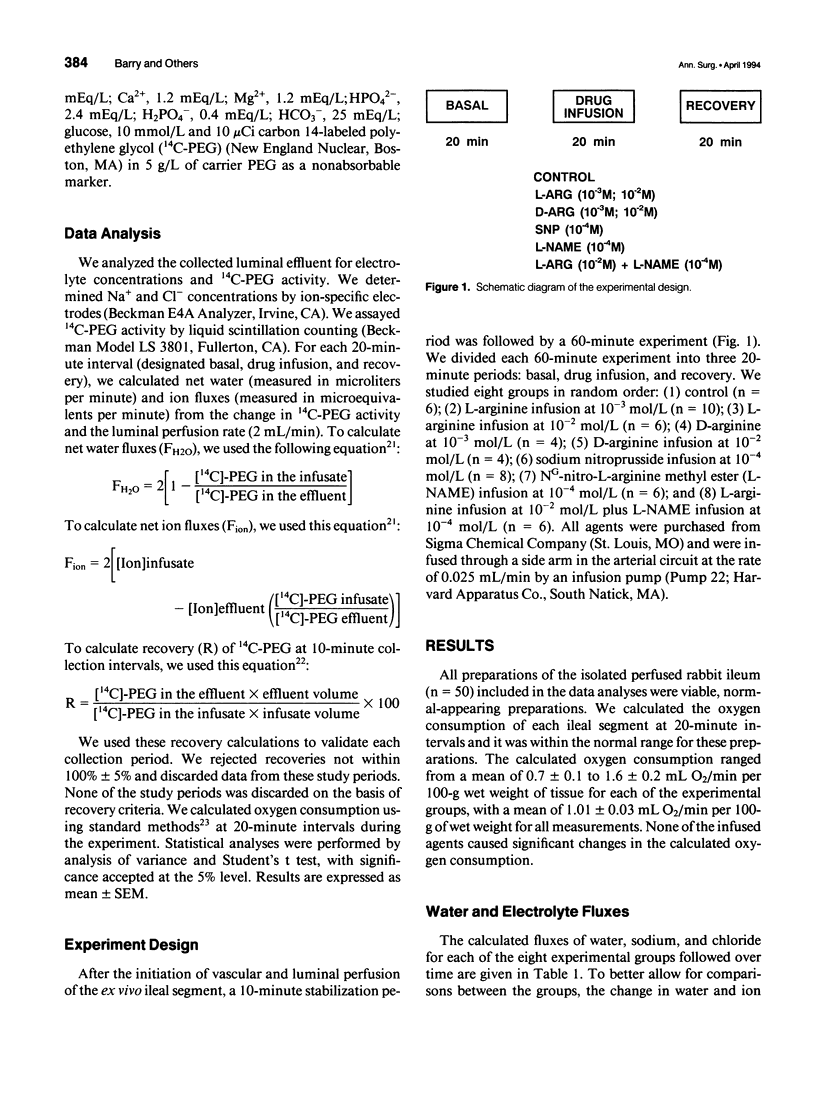
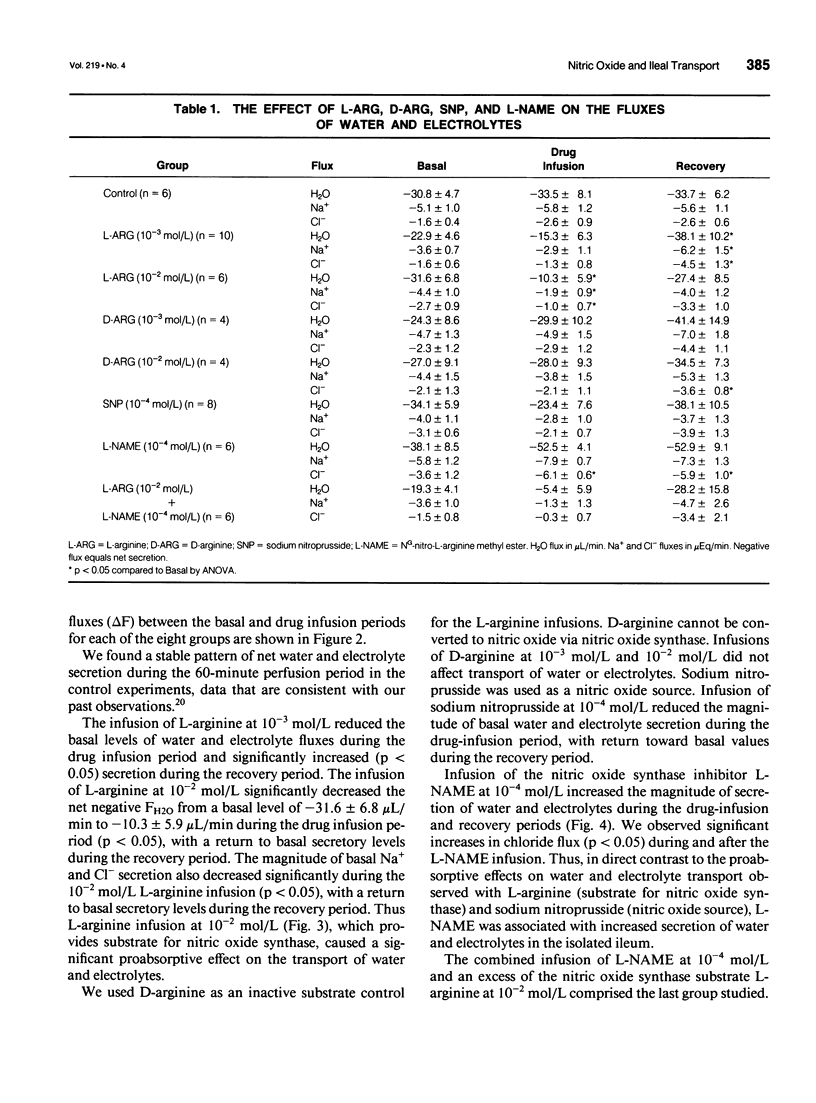

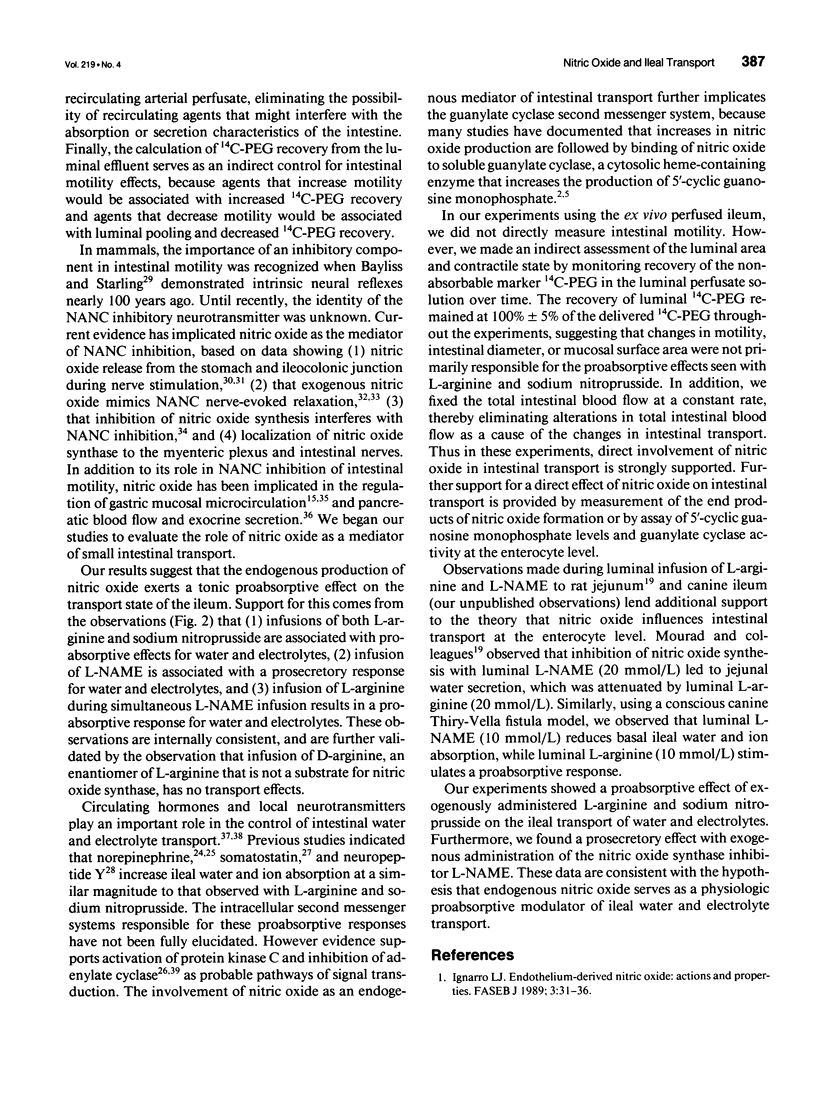
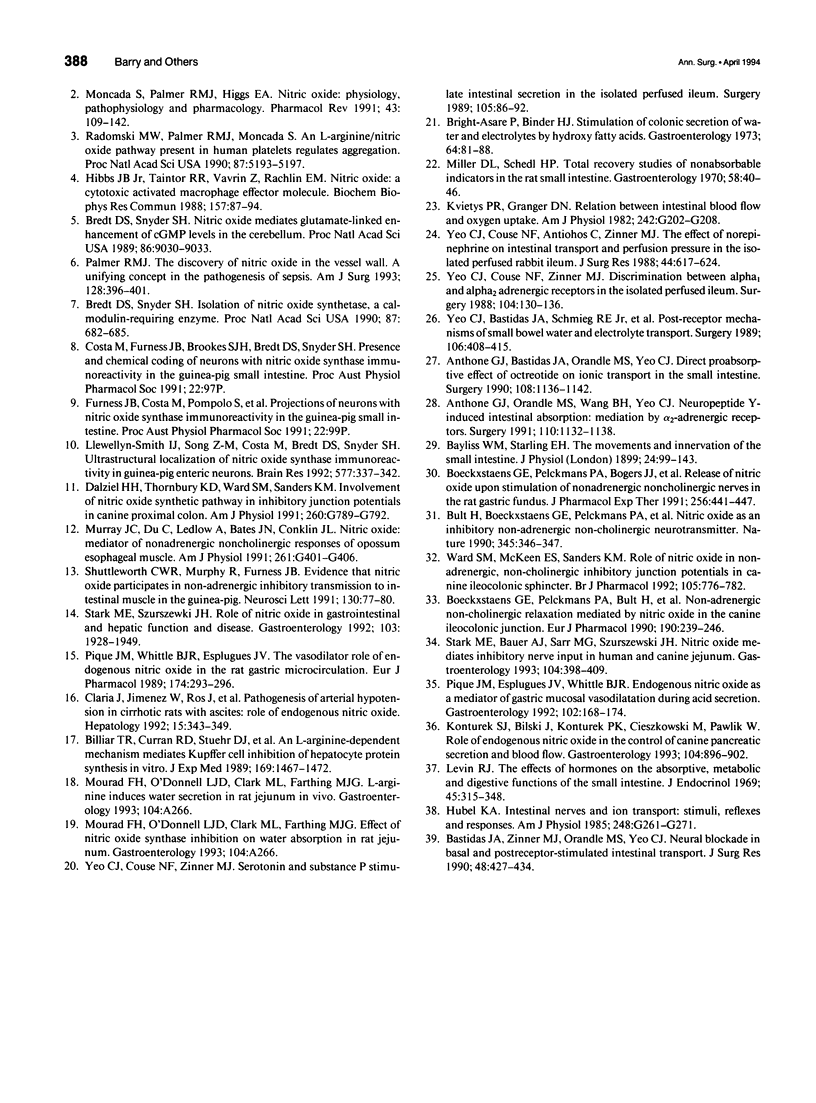
Selected References
These references are in PubMed. This may not be the complete list of references from this article.
- Anthone G. J., Bastidas J. A., Orandle M. S., Yeo C. J. Direct proabsorptive effect of octreotide on ionic transport in the small intestine. Surgery. 1990 Dec;108(6):1136–1142. [PubMed] [Google Scholar]
- Anthone G. J., Orandle M. S., Wang B. H., Yeo C. J. Neuropeptide Y-induced intestinal absorption: mediation by alpha 2-adrenergic receptors. Surgery. 1991 Dec;110(6):1132–1138. [PubMed] [Google Scholar]
- Bastidas J. A., Zinner M. J., Orandle M. S., Yeo C. J. Neural blockade in basal and postreceptor-stimulated intestinal transport. J Surg Res. 1990 May;48(5):427–434. doi: 10.1016/0022-4804(90)90007-o. [DOI] [PubMed] [Google Scholar]
- Bayliss W. M., Starling E. H. The movements and innervation of the small intestine. J Physiol. 1899 May 11;24(2):99–143. doi: 10.1113/jphysiol.1899.sp000752. [DOI] [PMC free article] [PubMed] [Google Scholar]
- Billiar T. R., Curran R. D., Stuehr D. J., West M. A., Bentz B. G., Simmons R. L. An L-arginine-dependent mechanism mediates Kupffer cell inhibition of hepatocyte protein synthesis in vitro. J Exp Med. 1989 Apr 1;169(4):1467–1472. doi: 10.1084/jem.169.4.1467. [DOI] [PMC free article] [PubMed] [Google Scholar]
- Boeckxstaens G. E., Pelckmans P. A., Bogers J. J., Bult H., De Man J. G., Oosterbosch L., Herman A. G., Van Maercke Y. M. Release of nitric oxide upon stimulation of nonadrenergic noncholinergic nerves in the rat gastric fundus. J Pharmacol Exp Ther. 1991 Feb;256(2):441–447. [PubMed] [Google Scholar]
- Boeckxstaens G. E., Pelckmans P. A., Bult H., De Man J. G., Herman A. G., Van Maercke Y. M. Non-adrenergic non-cholinergic relaxation mediated by nitric oxide in the canine ileocolonic junction. Eur J Pharmacol. 1990 Nov 6;190(1-2):239–246. doi: 10.1016/0014-2999(90)94132-h. [DOI] [PubMed] [Google Scholar]
- Bredt D. S., Snyder S. H. Isolation of nitric oxide synthetase, a calmodulin-requiring enzyme. Proc Natl Acad Sci U S A. 1990 Jan;87(2):682–685. doi: 10.1073/pnas.87.2.682. [DOI] [PMC free article] [PubMed] [Google Scholar]
- Bredt D. S., Snyder S. H. Nitric oxide mediates glutamate-linked enhancement of cGMP levels in the cerebellum. Proc Natl Acad Sci U S A. 1989 Nov;86(22):9030–9033. doi: 10.1073/pnas.86.22.9030. [DOI] [PMC free article] [PubMed] [Google Scholar]
- Bright-Asare P., Binder H. J. Stimulation of colonic secretion of water and electrolytes by hydroxy fatty acids. Gastroenterology. 1973 Jan;64(1):81–88. [PubMed] [Google Scholar]
- Bult H., Boeckxstaens G. E., Pelckmans P. A., Jordaens F. H., Van Maercke Y. M., Herman A. G. Nitric oxide as an inhibitory non-adrenergic non-cholinergic neurotransmitter. Nature. 1990 May 24;345(6273):346–347. doi: 10.1038/345346a0. [DOI] [PubMed] [Google Scholar]
- Clària J., Jiménez W., Ros J., Asbert M., Castro A., Arroyo V., Rivera F., Rodés J. Pathogenesis of arterial hypotension in cirrhotic rats with ascites: role of endogenous nitric oxide. Hepatology. 1992 Feb;15(2):343–349. doi: 10.1002/hep.1840150227. [DOI] [PubMed] [Google Scholar]
- Dalziel H. H., Thornbury K. D., Ward S. M., Sanders K. M. Involvement of nitric oxide synthetic pathway in inhibitory junction potentials in canine proximal colon. Am J Physiol. 1991 May;260(5 Pt 1):G789–G792. doi: 10.1152/ajpgi.1991.260.5.G789. [DOI] [PubMed] [Google Scholar]
- Hibbs J. B., Jr, Taintor R. R., Vavrin Z., Rachlin E. M. Nitric oxide: a cytotoxic activated macrophage effector molecule. Biochem Biophys Res Commun. 1988 Nov 30;157(1):87–94. doi: 10.1016/s0006-291x(88)80015-9. [DOI] [PubMed] [Google Scholar]
- Hubel K. A. Intestinal nerves and ion transport: stimuli, reflexes, and responses. Am J Physiol. 1985 Mar;248(3 Pt 1):G261–G271. doi: 10.1152/ajpgi.1985.248.3.G261. [DOI] [PubMed] [Google Scholar]
- Ignarro L. J. Endothelium-derived nitric oxide: actions and properties. FASEB J. 1989 Jan;3(1):31–36. doi: 10.1096/fasebj.3.1.2642868. [DOI] [PubMed] [Google Scholar]
- Konturek S. J., Bilski J., Konturek P. K., Cieszkowski M., Pawlik W. Role of endogenous nitric oxide in the control of canine pancreatic secretion and blood flow. Gastroenterology. 1993 Mar;104(3):896–902. doi: 10.1016/0016-5085(93)91028-g. [DOI] [PubMed] [Google Scholar]
- Kvietys P. R., Granger D. N. Relation between intestinal blood flow and oxygen uptake. Am J Physiol. 1982 Mar;242(3):G202–G208. doi: 10.1152/ajpgi.1982.242.3.G202. [DOI] [PubMed] [Google Scholar]
- Levin R. J. The effects of hormones on the absorptive, metabolic and digestive functions of the small intestine. J Endocrinol. 1969 Oct;45(2):315–348. doi: 10.1677/joe.0.0450315. [DOI] [PubMed] [Google Scholar]
- Llewellyn-Smith I. J., Song Z. M., Costa M., Bredt D. S., Snyder S. H. Ultrastructural localization of nitric oxide synthase immunoreactivity in guinea-pig enteric neurons. Brain Res. 1992 Apr 17;577(2):337–342. doi: 10.1016/0006-8993(92)90294-j. [DOI] [PubMed] [Google Scholar]
- Miller D. L., Schedl H. P. Total recovery studies of nonabsorbable indicators in the rat small intestine. Gastroenterology. 1970 Jan;58(1):40–46. [PubMed] [Google Scholar]
- Moncada S., Palmer R. M., Higgs E. A. Nitric oxide: physiology, pathophysiology, and pharmacology. Pharmacol Rev. 1991 Jun;43(2):109–142. [PubMed] [Google Scholar]
- Murray J., Du C., Ledlow A., Bates J. N., Conklin J. L. Nitric oxide: mediator of nonadrenergic noncholinergic responses of opossum esophageal muscle. Am J Physiol. 1991 Sep;261(3 Pt 1):G401–G406. doi: 10.1152/ajpgi.1991.261.3.G401. [DOI] [PubMed] [Google Scholar]
- Palmer R. M. The discovery of nitric oxide in the vessel wall. A unifying concept in the pathogenesis of sepsis. Arch Surg. 1993 Apr;128(4):396–401. doi: 10.1001/archsurg.1993.01420160034004. [DOI] [PubMed] [Google Scholar]
- Pique J. M., Esplugues J. V., Whittle B. J. Endogenous nitric oxide as a mediator of gastric mucosal vasodilatation during acid secretion. Gastroenterology. 1992 Jan;102(1):168–174. doi: 10.1016/0016-5085(92)91797-8. [DOI] [PubMed] [Google Scholar]
- Pique J. M., Whittle B. J., Esplugues J. V. The vasodilator role of endogenous nitric oxide in the rat gastric microcirculation. Eur J Pharmacol. 1989 Dec 19;174(2-3):293–296. doi: 10.1016/0014-2999(89)90324-5. [DOI] [PubMed] [Google Scholar]
- Radomski M. W., Palmer R. M., Moncada S. An L-arginine/nitric oxide pathway present in human platelets regulates aggregation. Proc Natl Acad Sci U S A. 1990 Jul;87(13):5193–5197. doi: 10.1073/pnas.87.13.5193. [DOI] [PMC free article] [PubMed] [Google Scholar]
- Shuttleworth C. W., Murphy R., Furness J. B. Evidence that nitric oxide participates in non-adrenergic inhibitory transmission to intestinal muscle in the guinea-pig. Neurosci Lett. 1991 Sep 2;130(1):77–80. doi: 10.1016/0304-3940(91)90231-h. [DOI] [PubMed] [Google Scholar]
- Stark M. E., Bauer A. J., Sarr M. G., Szurszewski J. H. Nitric oxide mediates inhibitory nerve input in human and canine jejunum. Gastroenterology. 1993 Feb;104(2):398–409. doi: 10.1016/0016-5085(93)90407-4. [DOI] [PubMed] [Google Scholar]
- Stark M. E., Szurszewski J. H. Role of nitric oxide in gastrointestinal and hepatic function and disease. Gastroenterology. 1992 Dec;103(6):1928–1949. doi: 10.1016/0016-5085(92)91454-c. [DOI] [PubMed] [Google Scholar]
- Ward S. M., McKeen E. S., Sanders K. M. Role of nitric oxide in non-adrenergic, non-cholinergic inhibitory junction potentials in canine ileocolonic sphincter. Br J Pharmacol. 1992 Apr;105(4):776–782. doi: 10.1111/j.1476-5381.1992.tb09056.x. [DOI] [PMC free article] [PubMed] [Google Scholar]
- Yeo C. J., Bastidas J. A., Schmieg R. E., Jr, Alexion P. W., Baraban J. M., Zinner M. J. Postreceptor mechanisms of small-bowel water and electrolyte transport. Surgery. 1989 Aug;106(2):408–415. [PubMed] [Google Scholar]
- Yeo C. J., Couse N. F., Antiohos C., Zinner M. J. The effect of norepinephrine on intestinal transport and perfusion pressure in the isolated perfused rabbit ileum. J Surg Res. 1988 May;44(5):617–624. doi: 10.1016/0022-4804(88)90170-9. [DOI] [PubMed] [Google Scholar]
- Yeo C. J., Couse N. F., Zinner M. J. Discrimination between alpha 1- and alpha 2-adrenergic receptors in the isolated perfused ileum. Surgery. 1988 Aug;104(2):130–136. [PubMed] [Google Scholar]
- Yeo C. J., Couse N. F., Zinner M. J. Serotonin and substance P stimulate intestinal secretion in the isolated perfused ileum. Surgery. 1989 Jan;105(1):86–92. [PubMed] [Google Scholar]


